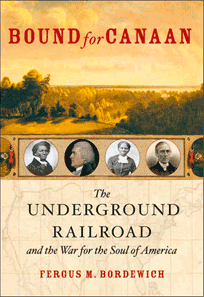
EXCERPTS: From The Intro
REVIEWS: Wall street Journal | Publisher’s Weekly | New Yorker | American Heritage | Civil War History | The Smithsonian | Kliatt | the Washington Post | the afrolumens project | the atlantic
Bound for Canaan
Review by Stanley Harrold in Civil War History
‘The first truly comprehensive treatment of the Underground Railroad
in over a century, and by far the best.’ť
UNDERGROUND RAILROAD is the collective term for antebellum grassroots networks that aided perhaps 100,000 African-Americans escape from slavery in the South to (limited) freedom in the North and Canada. Interest among scholars and readers in this phenomenon does not rival interest in the Revolutionary generation. But wide-spread engagement with underground railroad lore is evident in an upsurge in books and articles published on the subject, in local and national organizations devoted to investigating it, and in the recent opening in Cincinnati of the National Underground Railroad Freedom Center.
Anyone who shares this interest will welcome Fergus M. Bordewich’s Bound for Canaan. It is the first truly comprehensive treatment of the Underground Railroad in over a century, and by far the best. As Bordewich notes, there was never a monolithic, nationally organized system for aiding escaping slaves. Rather a variety of individuals, families, and communities cooperated. Bordewich focuses on participants ranging from former slaves to millionaires, from Quaker pacifists to militants like Harriet Tubman and John Brown. He describes dramatic incidents, including what became the model for Harriet Beecher Stowe’s ‘Eliza’ escape across a frozen Ohio River and violent rescues of fugitives from state and federal authorities. Distinguishing between slaves who escaped on their own and organized efforts to help them, he suggests that the movement began among Quakers in Pennsylvania and North Carolina during the early 1800s and spread to the Ohio River Valley during the 1820s.
Bordewich contends that by the late 1830s regional networks, maintained by black and white northerners, began on a regular basis to pass fugitive slaves northward along organized routes. Although he does not mention it, this was also the time that abolitionists believed the underground railroad began. It reached a peak during the 1850s as, stimulated by a biracial northern reaction to the intrusive new Fugitive Slave Law and spreading antislavery politics, it became ubiquitous across the North. Bordewich does not address Keith P. Griffler’s plausible thesis in Front Line of Freedom: African Amerians and the Forging of the Underground Railroad in the Ohio Valley (2004) that black communities on the north shore of the Ohio River took an early lead in helping fugitives. Bordewich nevertheless emphasizes throughout Bound for Canaan that the Underground Railroad was a cooperative undertaking among escaping slaves and sympathetic black and white activists.
Bound for Canaan is designed for a popular audience, and Bordewich presents his material as a series of stories centered on an escapees or those who assisted them. The style is impressionistic rather than analytical, and readers may grow weary as similar stories unfold. Yet the book is a virtual encyclopedia of information concerning the underground railroad and related topics ranging from resistance against slave catchers to black settlement in Canada. It is also serves as a history of the antislavery movement from the perspective of the underground railroad. Bordewich provides ample biographical, social, and political background information for each incident. Although he relies heavily on secondary sources—as might be expected in such comprehensive account—he frequently cites primary documents, revealing an impressive range of archival research. Because his scholarship is almost always current, the book will be very useful to historians. They may not like his imprecise system of notation based on page numbers and selected phrases. Bordewich, however, makes better use of this system than do others who employ it.
Some historians, influenced by Larry Gara’s The Liberty Line: The Legend of the Underground Railroad (1961), regard organized assistance to escaping slaves as either mythical or an essentially black undertaking. Gara himself aimed to correct an earlier over emphasis of white initiative in helping slaves escape. During the past decade numerous local and regional studies have portrayed biracial underground railroad networks in which slaves took an active and, indeed, decisive part. Bordewich’s excellent comprehensive account is a capstone for these studies. But a major methodological difficulty remains. Helping people escape slavery was an illegal, often clandestine, activity, carried out by people who usually did not keep records. Where he can, Bordewich relies on contemporary documents or on secondary studies based on such documents. But, like others before him, he frequently relies on reminiscences, autobiographies, memoirs, local histories, and interviews produced long after the underground railroad ceased to exist. As Gara pointed out, such memories can be self-serving and untrustworthy. They can also be very imprecise concerning chronology. Bordewich acknowledges this difficulty and treats such material carefully. Yet more may be understood as sophisticated approaches to memory are applied to these difficult sources.
This review by Stanley Harrold of South Carolina State University originally appeared in Civil War History journal.

